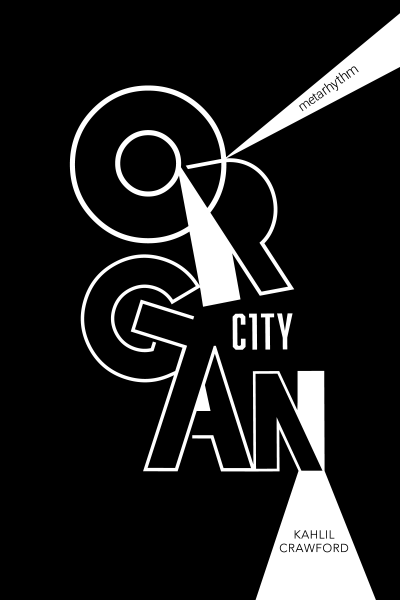Kahlil Crawford is a poet, essayist and theorist.
His work explores avant-garde art, music,
design and subculture beyond rhythm
(i.e. metarhythm). Writing in the tradition
of classic Jazz & Be-Bop, his work is driven
by UK Drum ’n Bass & Detroit Techno
as expressions of existential futurism.
Kahlil proudly holds degrees from Hampton
University, North Park University and the
School of Life.
ØRGΛN C1TY: metarhythm
Windy City Reviews
Who was it that said, “make it new”? And what did they mean when they said it? Who said it really doesn’t matter (no disrespect to Ezra Pound), but Kahlil Crawford’s ØRGΛN C1TY: metarhythm is a beautiful object with a multitude of visions. I start with the “make it new” adage because so little of what we’re exposed to can truly fit into that description. This work is a multimedia kaleidoscope in which each page, at least to this reader, is like going to an art exhibit and seeing something that you’ve never seen before.
The book as a physical object is a collaboration of sorts, but to me it’s clear that this is Crawford’s vision. The book does display in its table of contents an approach that appears threefold: Words, Visions, and Spirits. The “4word” and “Manifest” kick off the work as both an entry into the world the book conjures and a mission statement on what it hopes to achieve. Normally, any type of introductory material or attempt to explain anything related to the work is something I actively avoid when I open a book. In this case, neither of those pieces overexplain but instead serve as a mode of neural reconditioning. Because that’s what it takes to read this book—you need to rethink how you consume art and what art can do.
Fast forward to the pieces “Sound” and “Rhythm.” Both utilize typography in a unique way, a way that I don’t have the skill to reproduce here to do it proper justice, but I’ll give it a shot. Crawford’s lines in “Sound”: music is the most/kinetic art form →/acting in reverse ←/stimulating our potential/holding us captive ↓/elevating our being ↑/sometimes forever.
I’ve read a lot of books and I’m certain I have holes in my personal reading education, but I’ve never read anything like that before. The use of arrows as a device for situating the reader in the work, even right there in the lines, is truly ingenious. It’s a matter of being taught how to read some of these pieces, especially the two mentioned here, as you go along because with those typographic choices, you not only consume the words but consume a direction. A sense that when Crawford writes elevating our being ↑, you’re meant to register the meaning of the words in proximity to the symbol. Almost two levels of comprehension and understanding, a dual symbolism.
In “Rhythm,” we essentially see three different but similar patterns of rhythm: motion, meta, and plastic, all of which appear to deal with varying modes of culture and pop culture. They read like influences to the writer that have staying power and seem to renew each day through some type of existential consideration around what can motivate us. Crawford’s work can elicit an otherworldly response in a very short span of words as if inventing a new way of experience. There are other pieces like “Techno” and “Machine” that read like treatises on different technological concepts, each educational in its premise.
This is, no doubt, an important work. The themes in ØRGΛN C1TY are well connected and organized, and Crawford takes topics and presents them in a way that’s intellectually divergent. A lot of things are going on in this book, but that is not a slight—it’s a comment on a truly ambitious and meaningful creation.
~Mike Freveletti
His work explores avant-garde art, music,
design and subculture beyond rhythm
(i.e. metarhythm). Writing in the tradition
of classic Jazz & Be-Bop, his work is driven
by UK Drum ’n Bass & Detroit Techno
as expressions of existential futurism.
Kahlil proudly holds degrees from Hampton
University, North Park University and the
School of Life.
ØRGΛN C1TY: metarhythm
Windy City Reviews
Who was it that said, “make it new”? And what did they mean when they said it? Who said it really doesn’t matter (no disrespect to Ezra Pound), but Kahlil Crawford’s ØRGΛN C1TY: metarhythm is a beautiful object with a multitude of visions. I start with the “make it new” adage because so little of what we’re exposed to can truly fit into that description. This work is a multimedia kaleidoscope in which each page, at least to this reader, is like going to an art exhibit and seeing something that you’ve never seen before.
The book as a physical object is a collaboration of sorts, but to me it’s clear that this is Crawford’s vision. The book does display in its table of contents an approach that appears threefold: Words, Visions, and Spirits. The “4word” and “Manifest” kick off the work as both an entry into the world the book conjures and a mission statement on what it hopes to achieve. Normally, any type of introductory material or attempt to explain anything related to the work is something I actively avoid when I open a book. In this case, neither of those pieces overexplain but instead serve as a mode of neural reconditioning. Because that’s what it takes to read this book—you need to rethink how you consume art and what art can do.
Fast forward to the pieces “Sound” and “Rhythm.” Both utilize typography in a unique way, a way that I don’t have the skill to reproduce here to do it proper justice, but I’ll give it a shot. Crawford’s lines in “Sound”: music is the most/kinetic art form →/acting in reverse ←/stimulating our potential/holding us captive ↓/elevating our being ↑/sometimes forever.
I’ve read a lot of books and I’m certain I have holes in my personal reading education, but I’ve never read anything like that before. The use of arrows as a device for situating the reader in the work, even right there in the lines, is truly ingenious. It’s a matter of being taught how to read some of these pieces, especially the two mentioned here, as you go along because with those typographic choices, you not only consume the words but consume a direction. A sense that when Crawford writes elevating our being ↑, you’re meant to register the meaning of the words in proximity to the symbol. Almost two levels of comprehension and understanding, a dual symbolism.
In “Rhythm,” we essentially see three different but similar patterns of rhythm: motion, meta, and plastic, all of which appear to deal with varying modes of culture and pop culture. They read like influences to the writer that have staying power and seem to renew each day through some type of existential consideration around what can motivate us. Crawford’s work can elicit an otherworldly response in a very short span of words as if inventing a new way of experience. There are other pieces like “Techno” and “Machine” that read like treatises on different technological concepts, each educational in its premise.
This is, no doubt, an important work. The themes in ØRGΛN C1TY are well connected and organized, and Crawford takes topics and presents them in a way that’s intellectually divergent. A lot of things are going on in this book, but that is not a slight—it’s a comment on a truly ambitious and meaningful creation.
~Mike Freveletti
My Favourite Genres
How Heard






